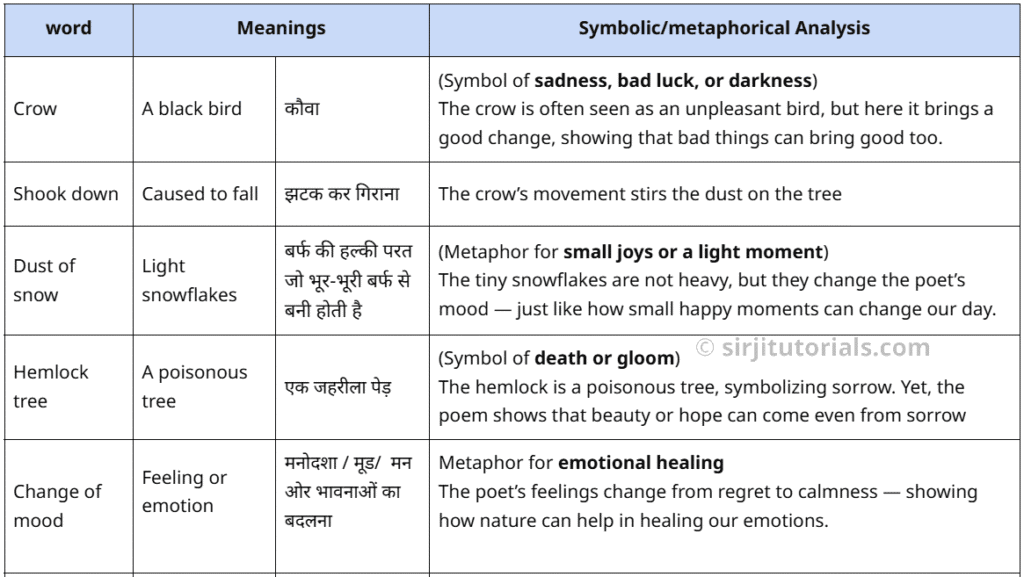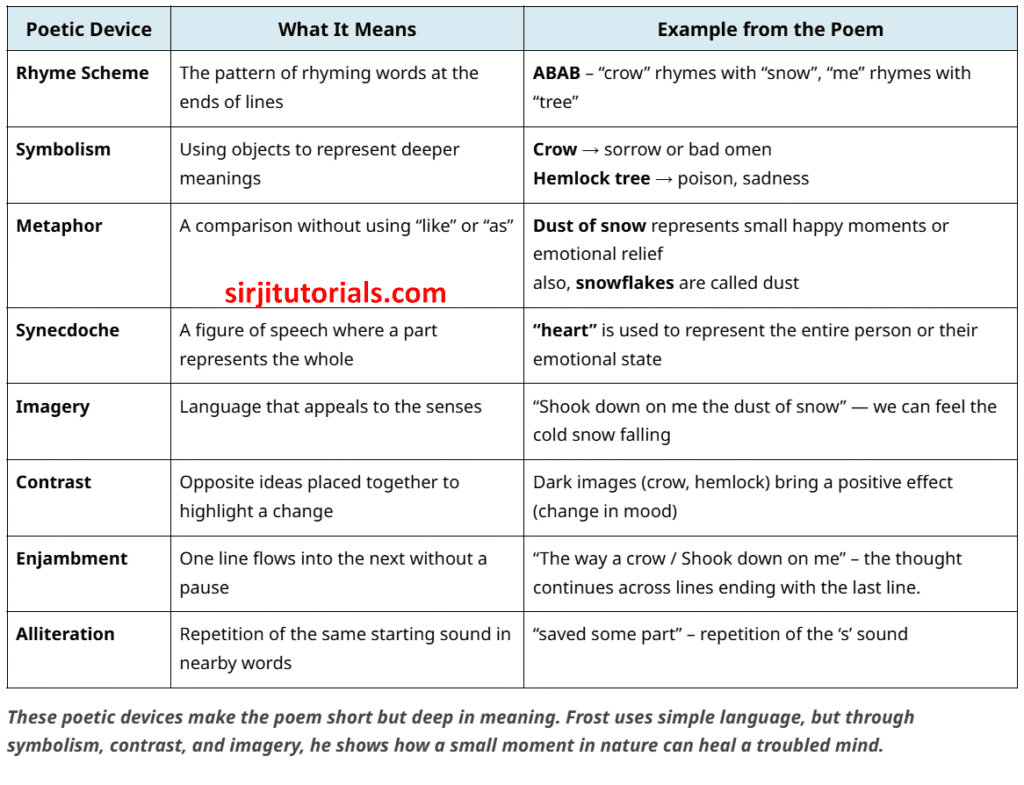“Dust of Snow” is a short poem by Robert Frost. It describes a simple moment when a crow shakes snow from a tree onto the poet, changing his mood and brightening his day. The poem highlights how small, unexpected events in nature can have a positive impact on our lives.
About the Poet (Robert Frost)
- American Poet – Robert Frost was a famous poet from the United States.
- Born in 1874 – He was born on March 26, 1874, and died in 1963.
- Known for Nature Poems – Many of his poems are about nature and simple rural life.
- Easy Language, Deep Meaning – His poems are written in simple words but carry deep thoughts.
- Famous Poems – Some of his best-known poems are “The Road Not Taken,” “Stopping by Woods on a Snowy Evening,” and “Dust of Snow.”
- Awards – He won the Pulitzer Prize four times, a great honor in literature.
Poem: Dust of Snow
By Robert Frost
The way a crow
Shook down on me
The dust of snow
From a hemlock tree
Has given my heart
A change of mood
And saved some part
Of a day I had rued.
Explanation & Analysis of ‘Dust of Snow’ Poem
The poem “Dust of Snow” is analysed stanza by stanza, highlighting its deeper meanings and exploring its symbolic and metaphorical elements.
Let’s explore and analyse the poem “Dust of Snow.”
Stanza 1of Dust of Snow:
The way a crow
Shook down on me
The dust of snow
From a hemlock tree
Explanation:
The way (manner) the crow behaved or engaged with the tree, caused dust on the hemlock tree to happen to fall on the poet or the speaker.
- The poet talks about a small moment in nature.
- A crow sitting on a hemlock tree (a kind of tree, often linked to sadness) shakes some snow off the branches.
- This snow falls on the poet.
⟶ Though crows and hemlock trees are usually seen as symbols of darkness or sorrow, here they become part or cause of a positive moment.
Line-by-Line Meaning & Analysis:
| Lines | Literal Meaning | Deeper Meanings |
|---|---|---|
| The way a crow | A black bird (crow) | Even something simple (a common bird) can matter. |
| Shook down on me | Shook its feathers so snow fell on the speaker | Sometimes kindness or change comes unexpectedly. |
| The dust of snow | A light sprinkle of snow | Small things (like “dust”) can have big effects. |
| From a hemlock tree | The snow fell from a hemlock tree’s branches | Nature often has simple ways to heal our feelings. |
Vocabulary Notes:

Stanza 2 of Dust of Snow:
Has given my heart
A change of mood
And saved some part
Of a day I had rued.
Meaning & Explanation:
The fall of dust of snow has brought or caused change in the feeling and emotions and this change saved the rest of the day which the poet had rued i.e. was hopeless of any good about.
- The poet’s mood changes because of this small event (falling of dust of snow).
- He was having a bad day — he had “rued” (regretted) it.
- But this little surprise from nature cheered him up.
- It saved a part of the day, making it feel better and less sad.
Line-by-Line Meaning & Analysis:
| Lines | Literal Meaning | Deeper Meaning |
|---|---|---|
| Has given my heart | Made the speaker feel differently inside | A tiny event can change how we feel inside. |
| A change of mood | Turned sadness into happiness | Our mood can shift quickly with the right moment. |
| And saved some part | Made part of his day better | Even a small part of our day can be “saved” from gloom. |
| Of a day I had rued. | He had been regretting or unhappy about the day | Regrets can be eased by simple, positive experiences. |
Vocabulary Notes:

Conclusion:
- Even small things in nature — like snow falling from a tree — can bring joy and change our mood for the better.
- Robert Frost uses dark or negative images (like the crow and the hemlock tree) to show something positive — a surprising change of heart.
- Nature has the power to heal our minds and lift our spirits, even if we’re having a bad day.
- The message is: Even unpleasant things in life can bring joy or meaning if we look at them differently.
Message in the Poem “Dust of Snow”
Keywords/Phrases:
“Little joys,” “Nature’s healing,” “Unexpected happiness,” “Shift in perspective,” “small wonders,” “Transformation,” “Hope & renewal,”
- Small things can have a big impact – A simple, fleeting moment (like a crow shaking snow) transforms the speaker’s mood, proving that even minor events can shift our outlook.
- Perspective shift: A tiny, chance moment can turn sorrow into cheer – What seemed like a ruined day turns joyful because of an unexpected incident, teaching us to find hope in small, chance occurrences.
- Joy in Unexpected Places (Even “negative” symbols can bring happiness) – Even elements traditionally seen as negative like the crow (often seen as ominous) and the hemlock tree (associated with poison)can be agents of positive change like joy, reminding us that beauty and hope can come from unlikely sources.
- Healing power of nature: Nature has the power to heal and uplift a depressed or sorrowful spirit. Natural elements (snow, hemlock tree) lift the speaker’s mood.
- Transformation – A small incident changes the speaker’s entire day.
- Appreciating life’s small blessings – The poem encourages us to value brief, beautiful moments that can brighten our darkest days.
Central Idea of the Poem “Dust of Snow”
The central idea of the poem is that even small and unexpected events in nature can have a big impact on our mood and thoughts.
In this poem, a tiny moment — snow falling from a tree due to a crow — helps the poet feel better on a bad day. It shows that nature has the power to heal, comfort, and change our feelings, even in simple ways.
In Simple Words:
- Sometimes, a little thing can brighten our mood.
- What seems unpleasant (like a crow or a hemlock tree) can still bring a good experience.
- We should appreciate small joys in life and understand that positive changes can come from unlikely places.
Theme of the Poem “Dust of Snow” by Robert Frost
The poem “Dust of Snow” shows how a small moment in nature can bring a big change in our mood. It tells us that even unpleasant things (like a crow or a hemlock tree) can lead to something positive and refreshing.
In simple words:
The theme of the poem is about hope, healing, and the power of small things to make us feel better, even on a bad day.
कविता “Dust of Snow” यह दिखाती है कि प्रकृति की एक छोटी-सी घटना भी हमारे मन की स्थिति को बदल सकती है।
कभी-कभी जो चीजें हमें साधारण या अशुभ लगती हैं (जैसे कौवा या हेमलॉक पेड़), वही हमें खुशी और आशा दे सकती हैं।
सरल शब्दों में:
इस कविता का विषय है — आशा, मन का बदलाव और छोटी-छोटी बातों में छिपी खुशी और शांति।
यह हमें सिखाती है कि हर दिन में कुछ अच्छा हो सकता है, बस हमें उसे पहचानना आना चाहिए।
Major Poetic Devices Used in the Poem “Dust of Snow” by Robert Frost
Here’s a table with the main poetic devices used in the poem, explained in simple English with examples:



